2—
Sketches, Editions, and Revisions
The Sketchbook
As has often been told, the story of The Rite began with a dream or "vision" of pagan ritual "in which a chosen sacrificial virgin danced herself to death."[1] Unaccompanied by "concrete musical ideas," this came to the composer in March of 1910, as he was completing The Firebird . But it was not until July, following performances of The Firebird in Paris, that he confronted Diaghilev with ideas for a new ballet on the subject. Diaghilev's immediate reaction is not known. The impresario may have had other plans for his newly enshrined protégé, namely, a ballet based on the theme of Edgar Allan Poe's The Masque of the Red Death .[2]
Following his return to Russia that summer, Stravinsky contacted Nicolas Roerich, a painter, ethnographer, and specialist in the field of Russian pagan history. Several Stravinsky-Roerich letters survive from this period, two of which point to the existence of early sketch material.[3] Their working title at this time was
[1] Igor Stravinsky and Robert Craft, Expositions and Developments (Berkeley: University of California Press, 1981), p. 140.
[2] See the Stravinsky-Roerich letter, dated July 2, 1910 (New Style), in "Letters to Nicholas Roerich and N. F. Findeizen," Appendix II in the accompanying booklet to Igor Stravinsky, The Rite of Spring: Sketches 1911–1913 (London: Boosey and Hawkes, 1969), p. 27. See also Vera Stravinsky and Robert Craft, Stravinsky in Pictures and Documents (New York: Simon and Schuster, 1978), pp. 77, 612.
[3] The two Stravinsky-Roerich letters that specifically mention early sketches are contained in Stravinsky, "Letters to Nicholas Roerich and N. F. Findeizen," pp. 27-29. Additional correspondence between Stravinsky and Roerich dating from 1910 has been published with annotations by Irina Vershinina in Sovetskaia muzyka 30, 8 (1966): 57–63.
"Great Sacrifice," and in a letter dated August 9, 1910, this is affectionately referred to as "our child": "I have started work (sketches) on the Great Sacrifice," Stravinsky wrote. "Have you done anything for it yet?"[4] Two drawings of Roerich's survive, but the sketch material has been lost.[5] Toward the end of September these plans were shelved as the composer became occupied with an entirely different project, a Konzertstück which would subsequently become the second tableau of Petrushka .
Nearly a year passed before the Stravinsky-Roerich collaboration was resumed. In Russia again after yet another triumphant appearance in Paris (this time with Petrushka ), Stravinsky visited Roerich in mid-July of 1911 to work out the details of a scenario. Their work on this seems from the start to have been a cooperative effort. The division into two parts, representing day and night (with the "Sacrifice" itself shifted to Part II), was Stravinsky's idea, while the rites or ceremonies to be depicted by the individual dance numbers were in large part suggested by Roerich.[6]
To judge from Stravinsky's sketchbook, the original 1911 chronology of the movements and some of the titles as well differed in significant respects from the outline of the finished score. (The sketchbook is our only source of information on this: the earliest surviving descriptions of the scenario postdate the completed score, having been prepared during the period leading directly up to the premiere.) This is not to say that the simple sequence of ideas in the sketchbook is invariably reliable as a guide in these respects: inevitably, sketches for one dance overlap those of another. On page 7, for example, there are preliminary ideas for the "Ritual of Abduction" and the "Ritual of the Rival Tribes," although this page is ostensibly devoted to the "Spring Rounds."[7] It is apparent, moreover, that the movements of Part II were composed even less systematically than those of Part I. The sketches for Part II's Introduction and "Mystic Circles of the Young Girls" were composed more or less simultaneously on pages 50–66, while ideas for the following "Glorification of the Chosen One" are anticipated on pages 52, 59, 61, and 66, although not until page 67 does its composition get fully underway. Indeed, in one of the sketchbook's more curious anomalies, the "Ritual Action of the Ancestors" was at one point conceived as the concluding movement of The Rite . Prefacing the final
[4] Stravinsky, "Letters to Nicholas Roerich and N. F. Findeizen," p. 29.
[5] Of the three drawings sketched by Roerich in 1910, one was given to Stravinsky as a gift and was subsequently lost during the war along with the rest of his belongings at Ustilug. The other two were listed in a 1916 catalogue as belonging to Roerich's wife and B. G. Vlasiev. For further details see Richard Taruskin, "The Rite Revisited: The Idea and the Sources of Its Scenario," in Edmond Strainchamps and Maria Rika Maniates, eds., Music and Civilization: Essays in Honor of Paul Henry Lang (New York: Norton, 1984), p. 188.
[6] See Robert Craft, "The Rite of Spring : Genesis of a Masterpiece," Perspectives of New Music 5, 1 (1966): p. 23.
[7] The first entry on page 7 is the Tranquillo melody that frames the "Spring Rounds." As indicated in the preceding chapter (see Example 2), this melody was derived from the Juszkiewicz anthology of Lithuanian folk songs.
sketches for this dance on page 82, an inscription reads: "End of Part II of the Sacre " and, in parenthesis, "after the 'Sacrificial Dance.'"
Nonetheless, as shown in Table 1, an approximation of the early 1911 chronology and titles may be deduced, and, by way of the chronology, an account of the compositional progress itself from the "Augurs of Spring" on pages 3–6 to the end
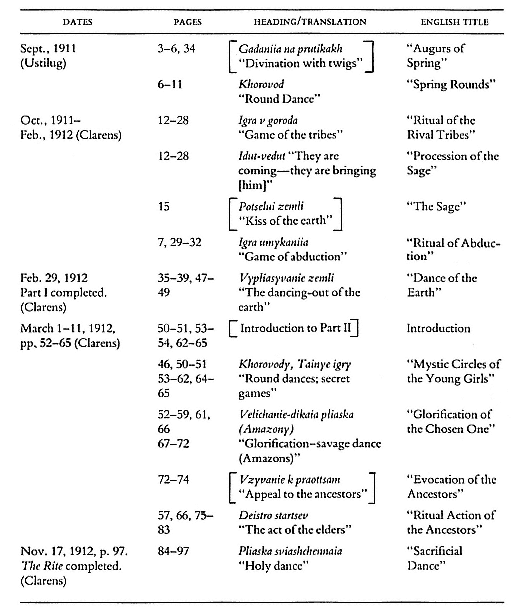
Table 1:
Chronology of the sketchbook
of the "Sacrificial Dance."[8] This chronology extends only to page 97, however, at which point there appear the by now celebrated lines: "Today 4/17 November, 1912, Sunday, with an unbearable toothache I finished the music of the Sacre . I. Stravinsky, Clarens, Châtelard Hotel."[9] The remaining pages of the total of 140 reproduced in facsimile consist of orchestral elaborations of sections from the "Sacrificial Dance," the Introduction to Part II, the "Augurs of Spring," and the "Ritual of Abduction."[10]
Ten principal Russian headings are included in Table 1.[11] Alongside these are literal English translations, the corresponding English titles from the 1967 edition, and the encompassing page numbers from the sketchbook. With the exception of Vypliasyvanie zemli, the headings are all Roerich's. Vypliasyvanie is Stravinsky's unique contribution to the titles, a neologism suggesting the stamping character of the sixth dance; it means, literally, the "Dancing-Out of the Earth" rather than the "Dance of the Earth." (Stravinsky later recalled imagining the dancers "rolling like bundles of leaves in the wind" at the beginning of this dance, while the rapid triplet figuration later suggested the stamping of Indians "trying to put out a prairie fire.")[12] There are two competing tribes in the "Ritual of the Rival Tribes," while the rhythmic turbulence of the "Glorification of the Chosen One" (or "Savage Dance"; see Table 1) at one time suggested an Amazonian scene. The Amazon idea was later abandoned as inappropriate and unworkable. The sketchbook lacks titles
[8] Page 3 is the first page of musical illustrations. The initial page bears the 1911 title Vesna sviashchennaia ("Holy Spring") and a dedication to Diaghilev that was added in October, 1920. The second page is a roster of instruments.
[9] The double-dating in the "4/17 November, 1912" inscription refers to Old Style (4 November) and New Style (17 November).
[10] Also included on pages 97–140 are sketches for The Nightingale , the Souvenirs de mon enfance, Berceuses du chat , and the first two of the Three Japanese Lyrics .
[11] The title "Divination with Twigs" is taken from the Stravinsky-Roerich letter of September 26, 1911, quoted in Chapter 1. The transliterations and translations in Table 1 are derived from Richard Taruskin, "The Rite Revisited," and from Simon Karlinsky, "The Composer's Workshop," The Nation , June 15, 1970, p. 732. Generally speaking, the translations by both Taruskin and Karlinsky are more explicit than many of those furnished by Robert Craft in his "Commentary to the Sketches," Appendix I in the accompanying booklet to Stravinsky, The Rite of Spring: Sketches 1911–1913. Igra means "game," although, in relation to both the scenario and composition of The Rite , "rite" or "ritual" is more appropriate. Karlinsky translates Igra umykaniia , the original Russian title for "Ritual of Abduction," as "Mock Abduction of the Bride," a title that conveys a good deal more of the original, primitive rite than either the more literal "Game of Abduction" in Table 1 or the Stravinsky-Craft rendition, "Game of Seizing the Girl," in "Commentary to the Sketches," p. 10. And Idut-vedut , which Craft transcribes as eedoot-veedoot and translates as "Leading-moving" ("Commentary to the Sketches," pp. 5–8), means, more literally and essentially apropos of the "Rival Tribes" and its succeeding "Procession," "they are coming—they are bringing [him]." In their own English translations in both the "Commentary to the Sketches" and the 1967 edition of the score, Stravinsky and Craft may have been torn between some of these more precise translations, the less precise but established French translations, and the practical need for short and concise titles. Stravinsky may also have forgotten some of the implications of the original scenario and stage action. The February 29, 1912, date for the completion of Part I in Table 1 derives from page 43 of the autograph of the full score, which is the last page of the "Dance of the Earth."
[12] Craft, "The Rite of Spring : Genesis of a Masterpiece," p. 30.
for the "Augurs of Spring," "The Sage," and the "Evocation of the Ancestors," yet the sketches on pages 3–6 and 73–74 for the "Augurs" movement and the "Evocation," respectively, clearly indicate that these dances were conceived as independent episodes.
It may be useful to compare Table 1 with the chronology and titles of the completed score, given below. The French translations in this chronology were reproduced in all editions of the score beginning with the 1913 publication of the four-hand piano version; the English titles are once again those of the 1967 edition.
|
A synopsis of the final scenario may also prove helpful. There are three early accounts by Stravinsky, two of which were cited in Chapter 1: the synopsis sent to N. F. Findeizen in a letter dated December 15, 1912, and the description included in the controversial Montjoie! interview on the eve of the premiere. A third, sent to Sergei Koussevitsky as a program note for the latter's performance of The Rite in Moscow, February, 1914, reads as follows:
Vesna sviashchennaia is a musical-choreographic work. It represents pagan Russia and is unified by a single idea: the mystery and great surge of the creative power of Spring. The piece has no plot, but the choreographic succession is as follows:
First Part: THE KISS OF THE EARTH
The spring celebration. It takes place in the hills. The pipers pipe and the young men tell fortunes ["Augurs of Spring"]. The old woman enters. She knows the mystery of nature and how to predict the future. Young girls with painted faces come in from the river in single file. They dance the spring dance. Games start ["Dance of the Abduction"]. The Spring Khorovod ["Spring Rounds"]. The people divide into two groups, opposing each other ["Ritual of the Rival Tribes"]. The holy procession of the wise old man ["Procession of the Sage"]. The oldest and wisest interrupts the spring games, which come to a stop. The people pause trembling before the great action. The old men bless the earth ["The Sage"]. The Kiss of the Earth. The people dance passionately on the earth, sanctifying it and becoming one with it ["Dance of the Earth"].
Second Part: THE GREAT SACRIFICE
At right the virgins hold mysterious games, walking in circles ["Mystic Circles of the Young Girls"]. One of the virgins is consecrated and is twice pointed to by fate, being caught twice in the perpetual circle. The virgins honor her, the chosen one, with a marital dance ["Glorification of the Chosen One"]. They invoke the ancestors ["Evocation of the Ancestors"] and entrust the chosen one to the old wise men ["Ritual Action of the Ancestors"]. She sacrifices herself in the presence of the old men in the great holy dance, the great sacrifice ["Sacrificial Dance"].[13]
Notice in Table 1 that the Idut-vedut in the sketchbook ("they are coming, they are bringing [him]," i.e., the Sage) became, at no. 67 in the final score, the "Procession of the Sage." Flowing into one another without interruption, the "Ritual of the Rival Tribes" and its succeeding "Procession" were in fact composed as a single, continuous unit, on pages 12–28. The sketches on the first of these pages are reproduced in Example 5; notice that the fourth entry on this page is already the G





[13] V. Stravinsky and Craft, Stravinsky in Pictures and Documents , p. 75. On p. 78 a facsimile of Stravinsky's original draft of this synopsis is misdated "1910. The libretto in Stravinsky's hand." A different translation of this synopsis appears on p. 526.
[14] Often enough in the sketchbook, Stravinsky seems to have been able to capture, in his initial sketches for a particular dance movement, the shape of the movement as a whole. For the "Sacrificial Dance," all the main ideas are sketched in preliminary fashion on pages 84–85.
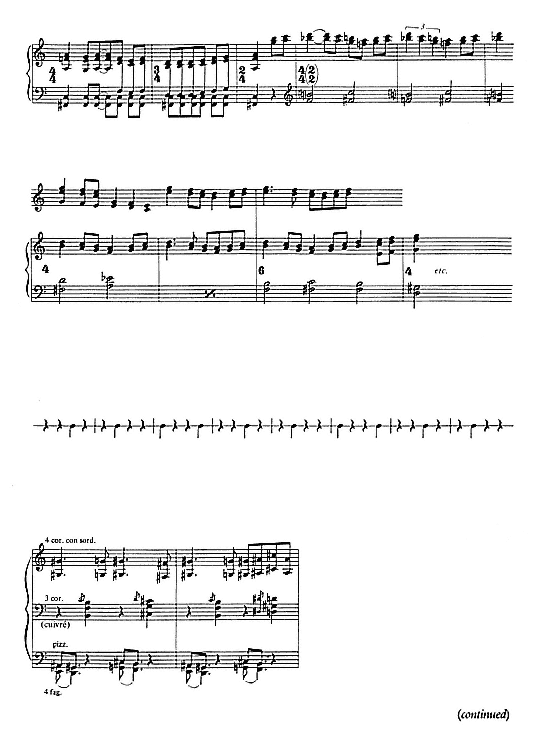
Example 5:
Sketchbook, p. 12
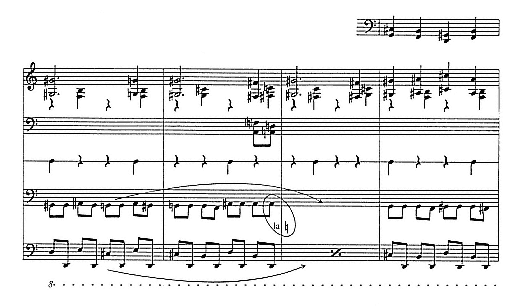
Example 5
(continued)
for no. 67 at the foot of page 12. Here, too, the accompanying three-against-four rhythm of the percussion, hypothesized just above, falls neatly into place.[15]
Indeed, while the first entry on page 12 is only a rough approximation of the beginning of the "Rival Tribes" (the blocks of material at nos. 57 and 57 + 4 are missing), the melody at m.3 in this entry, transposed to (G-F-E-D), is already superimposed over the Sage's theme in a development on page 13 (see Example 6). Of course, page 13 reverts to the theme's earlier "incorrect" halved rhythm. Yet the conditions of the theme's initial appearance at no. 64 are here firmly in place, and on page 16 the composer signals the end of this music with some remarkably accurate sketches for the conclusion of the "Rival Tribes." In the ensuing pages, 16–28, only the pitches of the new counter-theme in the horns, A-D-C-D in the final version, and the rhythmic coordination of this theme with that of the Sage would continue to pose problems.
A sketch of the quiet, four-bar interlude of "The Sage" appears on page 15
[15] The sketchbook scoring of this theme for muted horns instead of tubas is surprising, especially since, on pages 19 and 23, the new counter-theme is also scored for horns, pavillon en l'air . At some point Stravinsky must have realized that by scoring these two themes for different instruments (tubas and horns), the conflicting rhythmic-metric periods could more readily be brought to the fore.
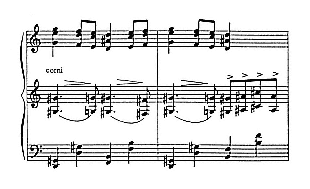
Example 6:
Sketchbook, p. 13
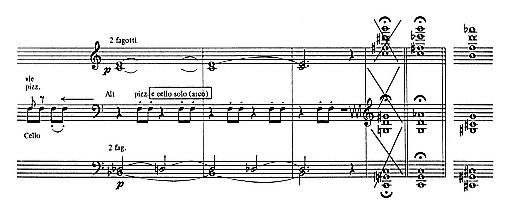
Example 7:
Sketchbook, p. 15
(Example 7). This ends with a double bar and fermata and was clearly intended, early on in these sketches for the "Rival Tribes" and "Procession," to serve as a conclusion to these movements.[16] Only later was this episode given a name of its own, Potselui zemli or "The Kiss of the Earth," a title that Stravinsky preferred not only to Le Sage or "The Sage" at no. 71, but to "Adoration of the Earth" for Part I as a whole. In accord with the original stage action at this point, the Sage entered at no. 70, where, as was noted in Chapter 1, the rhythmic-metric conflict of the two
[16] In Example 7 the draft of the string chord on the far right (for the most part transposed up a half-step) was composed first. Despite obvious discrepancies between this initial sketch and the completed score, the accuracy of this anticipation on page 15 is striking.
reiterating themes, G





But the real chronological shocker of the sketchbook entails the location in Part I of the "Ritual of Abduction." Originally, the "Abduction" followed "The Sage," while in the final score it comes immediately after the first dance, the "Augurs of Spring." The initial ordering is borne out musically in a number of interesting ways. For example, the C-B timpani fragment at no. 38 in the "Abduction" was derived from the C-B timpani-tuba motive that begins the "Rival Tribes" at no. 57 and was obviously intended to serve as an immediate link between the earlier "games" of the tribes and those of "abducting the bride."[17] Similarly, the climactic passage of the "Abduction" at no. 43 stemmed from the second motivic block of the "Rival Tribes" at no. 57 + 2.
It is not known precisely when the movements of Part I were arranged in their present order. But the reasons for the arrangement must have been both dramatic and musical. Scenically, the climax of Part I is the four-bar interlude of "The Sage"; coming after the feverish build-up of the "Rival Tribes" and the "Procession," it serves as a useful buffer, a brief, tranquil moment of release. To have returned after "The Sage" to yet another "game"—to have followed it by not one but two dance movements of considerable length and complexity, the "Ritual of Abduction" and the "Dance of the Earth"—would most assuredly have been anticlimactic. In addition, the rapid triplet figuration introduced at no. 75 in the "Dance of the Earth" (one quarter-note equals 168) bears too close and potentially too confusing or monotonous a correspondence with the rapid



[17] On page 29 of the sketchbook, the C-B motive now at no. 38 was originally scored for timpani and tuba, as at no. 57 in the "Rival Tribes." Only after reshuffling these movements did Stravinsky decide to save the tuba for the "Rival Tribes."
[18] In the 1913 four-hand piano version, the marking for the "Dance of the Earth" was slightly faster: one quarter-note equaled 186.
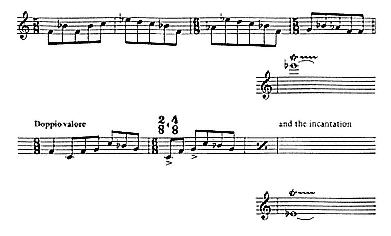
Example 8:
Sketchbook, p. 30
Another curiosity of the sketchbook is the near-total absence of sketches that relate to the Introduction to Part I. There are three brief entries: a notation on page 3 of the chordal progression at no. 12 + 6 (shown in Example 58, Chapter 6), a sketch on page 5 of the clarinet piccolo melody at no. 9 + 2 (which is part of a draft for no. 21 in the "Augurs of Spring"), and an orchestral draft on page 117 of the eleven measures at nos. 1–2 (which looks odd because the continuation of the principal bassoon melody is missing). This neglect is but one of the many missing links that have inspired the widespread assumption that many other sketches and orchestral drafts must have existed at the time of the sketchbook, nearly all of which are presumably lost. For a time Stravinsky was thought to have retained his sketches for Part I's Introduction,[19] but a careful inspection of the Nachlass, undertaken by the New York City Library in 1983, uncovered no such items. In fact, as far as The Rite is concerned, the Stravinsky Archives proved something of a disappointment: a notebook dating from 1912 to 1918 contained just two pages of sketches for Part II's Introduction and "Sacrificial Dance," while a separate folder contained seven
[19] See Appendix C in Eric Walter White, Stravinsky: The Composer and His Works (Berkeley: University of California Press, 1966), pp. 553–54. Items 3b and 3c in this directory of manuscripts in Stravinsky's possession, compiled by Robert Craft in 1954, were for a while believed to contain sketches for the Introduction to Part I.
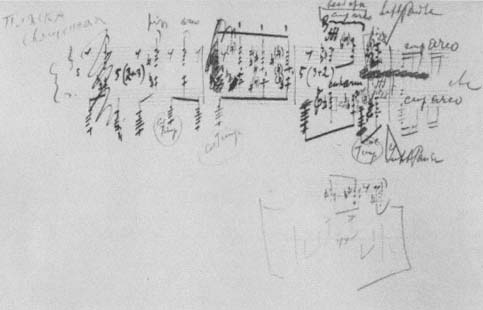
Figure 1:
An early sketch of the music at no. 147 in the "Sacrificial Dance," taken from a small notebook
dating from 1912 to 1918. The detailed instrumental cues appear to have been super-imposed
after the completion of the sketch. Notice the pizz-arco indication in the first and third measures.
These markings would eventually find their way into the 1913 autograph, but they were deleted
in the 1921 edition of the score and in the 1929 revised edition as well.
Courtesy of the Paul Sacher Foundation.
pages of an orchestral draft of the 1943 revision of the "Sacrificial Dance."[20] Much later, Stravinsky maintained that Part I's Introduction was composed after the other movements of this part had been completed.[21] There are no letters or documents that contradict this assertion.
[20] The results of this initial inspection, an inventory of the musical manuscripts in the Stravinsky Archives, are given in John Shepard, "The Stravinsky Nachlass : A Provisional Checklist of Music Manuscripts," Music Library Association Notes 40, 4 (1984): 719–50. In the notebook dating from 1912 to 1918, the first of the two pages includes a sketch of the music at nos. 147–49 in the "Sacrificial Dance." The sketch is very similar to the one on the second line on page 85 of the sketchbook of The Rite and may in fact have been composed at about the same time. There are detailed instrumental cues which appear to have been superimposed at a later date; many of these were eventually to find their way into the 1913 autograph. A facsimile of this sketch is reproduced in Figure 1. Sketches on the second of the two pages in the notebook pertain to the massive chordal progression at nos. 82 and 161 in the Introduction and "Sacrificial Dance" and are reproduced in Figure 4, Chapter 7.
[21] Stravinsky and Craft, Expositions and Developments , p. 141.
The sketchbook was begun during the summer of 1911, either before or soon after Stravinsky's visit with Roerich in mid-July. In August the composer traveled to Karlsbad, Warsaw, Lugano, and finally to Berlin to confer with his publisher, Russischer Musik Verlag. Craft cites the earliest notations for the "Augurs of Spring" on page 3 as having been composed either on or around September 2, after the composer's return from Berlin.[22] There is general agreement that the sketches for the "Augurs of Spring," "Spring Rounds," and possibly even portions of the "Ritual of the Rival Tribes" were composed at Stravinsky's summer residence in Ustilug, Russia.
In late September Stravinsky moved to a pension in Clarens, Switzerland, where the remaining movements of Part I were composed in the fall and early winter of 1911–1912. In January, while completing his sketches for Part I's concluding "Dance of the Earth," he may have received word of Diaghilev's decision to postpone production of The Rite until May of 1913. Sketches for the "Dance of the Earth" are interrupted on pages 41–45 for Act II of The Nightingale, and Stravinsky spent the greater part of February in London with the Ballet; neither the interruption nor the trip to London seems likely had he at this time still been pressed by the original performance dateline of June, 1912. The concluding sketches for the "Dance of the Earth" are on page 49, which includes an inscription heralding the "End of the Second Tableau." Apart from a brief anticipation on page 46, the first ideas for Part II are sketched on pages 50 and 51, and these refer to the Introduction and the "Mystic Circles of the Young Girls."
Dated March 1, 1912, an explosive sketch on page 52 for the section at no. 106 in the "Glorification of the Chosen One" (or "Savage Dance") may have coincided with the composer's return from London to Clarens. Following this, however, pages 52–65 return for the most part to the painstaking work of the Introduction and the "Mystic Circles." There are no fewer than seven separate notations for the Khorovod melody alone on these pages, and it is evident that the slow, chromatic lyricism of Part II's opening movements caused considerable difficulty. The explosive anticipations of the "Glorification of the Chosen One" on pages 52, 59, 61, and 66 doubtless convey the composer's impatience at this point, and the difficulty is all the more apparent when pages 52–65 are compared to some of the initial sketches for both the "Glorification" and the "Sacrificial Dance." These latter are almost fully developed and reveal great fluency. The comparison might seem paradoxical at first since these movements are faster and are metrically more irregular, hence more radical or "revolutionary" in appearance. Yet they are also composed in an idiom that even at this date may have come more naturally to the composer. In addition, the pianistic element in both the "Glorification" and "Sacrificial Dance" is conspicuous, and the sketches for these dances were undoubtedly prefaced by a considerable amount of keyboard improvisation. (Stravinsky composed The
[22] V. Stravinsky and Craft, Stravinsky in Pictures and Documents , p. 596.
Rite —indeed, nearly all his music—at the piano.)[23] Notice, in the opening sections of both dances, the rapid back-and-forth motion between the bass-timpani and tutti orchestra, a motion strikingly suggestive of the left hand-right hand alternation of the pianist. When rehearsing these passages during the 1920s and 1930s, the composer often recommended that bassists and timpanists visualize themselves as a pianist's left hand, the tutti orchestra as the same pianist's right hand. The tactic seems to have enhanced both the precision and the general rhythmic feel of this music.[24]
Following Part II's opening movements, the compositional pace slackened somewhat. Stravinsky worked only intermittently on The Rite during the remainder of 1912 and into 1913, his schedule now filled with appearances throughout Europe with the Ballets Russes. In April, 1912, he traveled to Monte Carlo for performances of The Firebird and Petrushka, and it was there that much of The Rite was unveiled for Diaghilev and Pierre Monteux. Monteux's recollection of this early audition is worth recounting, although his claim to have heard "the entire score" is improbable. Stravinsky may have omitted a great deal at the time or may simply have played through some of the as-yet-undecided passages in a quasi-improvisational fashion.
With only Diaghilev and myself as audience, Stravinsky sat down to play a piano reduction of the entire score. Before he got very far I was convinced he was raving mad. Heard this way, without the color of the orchestra which is one of its greatest attractions, the crudity of the rhythm was emphasized, its stark primitiveness underlined. The very walls resounded as Stravinsky pounded away, occasionally stamping his feet and jumping up and down to accentuate the force of the music. Not that it needed such emphasis.[25]
The composer was in Paris in late May and June for ballet productions of Debussy's L'Après-midi d'un faune and Ravel's Daphnis et Chloé, and on June 9 he played through his four-hand piano arrangement of The Rite with Debussy. (This arrangement was probably complete to the end of Part I.[26] Debussy was a formidable reader at sight, and his amusement at some of the unaccustomed rhythmic difficulties of the new score has often been recorded.)[27] Dated November 17, 1912, the sketchbook's announcement heralding the completion of the music, "with an unbearable toothache," has been noted. Later in November Stravinsky traveled to
[23] "I am no mystic," Stravinsky wrote. "I need to touch music as well as to think it, which is why I have always lived next to a piano." (Igor Stravinsky and Robert Craft, Themes and Conclusions [Berkeley: University of California Press, 1983], p. 119.) For a brief discussion of the role of the piano in Stravinsky's inventive processes, see Pieter C. van den Toorn, The Music of Igor Stravinsky (New Haven: Yale University Press, 1983), pp. 204–6, 210–11.
[24] Craft, "Commentary to the Sketches," p. 17.
[25] "Early Years," in Minna Lederman, ed., Stravinsky in the Theatre (New York: Pellegrini and Cudahy, 1949), pp. 128–29.
[26] See V. Stravinsky and Craft, Stravinsky in Pictures and Documents , pp. 87, 613.
[27] Ibid., p. 87.
Berlin, where the first dance rehearsals of The Rite took place. The composer himself supervised several of these, using a two-hand piano version of Part I, and, as with auditions in succeeding decades, these rehearsals left an indelible mark on several of the participants. It may be surmised that tempo and rhythmic precision were major performance problems.
Hearing the way his music was being played, [Stravinsky] blazed up, pushed aside the fat German pianist, nicknamed "Kolossal" by Diaghilev, and proceeded to play twice as fast as we had been doing and twice as fast as we could possible dance. He stamped his feet on the floor and banged his fist on the piano and sang and shouted.[28]
As will have been gathered, Stravinsky was preparing two-hand and four-hand piano arrangements as he continued with his work on the instrumentation. Nijinsky used the two-hand arrangement of Part I for his early rehearsals, including those conducted in London during February, 1913. Russischer Musik Verlag began their printing of the four-hand arrangement in January of 1913, and this was published in May, several weeks before the premiere.[29]
The full autograph of the orchestral score is dated and signed "completed in Clarens, March 8, 1913."[30] But on March 29 Stravinsky inserted four additional measures just before no. 86 in the Introduction to Part II (this may be the last music to have been composed for The Rite ),[31] while in early April he continued to revise
[28] Dame Marie Rambert, Quicksilver (London: Macmillan, 1972), quoted in V. Stravinsky and Craft, Stravinsky in Pictures and Documents , p. 90.
[29] It was on a copy of this arrangement that the composer entered his notations for the choreography. A facsimile of a page from the "Sacrificial Dance" may be found in V. Stravinsky and Craft, Stravinsky in Pictures and Documents , p. 79. Stravinsky's original two-hand piano version of The Rite has been lost.
[30] Boosey and Hawkes acquired the autograph of the full score in 1947 from Russischer Musik Verlag. In 1962, on his eightieth birthday, the manuscript was given to Stravinsky, at which time it was placed in a bank vault in Geneva, Switzerland. In Zurich in October of 1968, the composer gave it to his wife, Vera Stravinsky, who sold it in May, 1974, to Paul Sacher.
[31] This is Craft's guess in Robert Craft, ed., Stravinsky: Selected Correspondence , vol. 1 (New York: Knopf, 1982), p. 398. Yet the issue remains complex. According to André Schaeffner, Strawinsky (Paris: Rieder, 1931), p. 31, the eleven measures at nos. 86–88 in Part II's Introduction were the last to be composed. As evidence for the four bars that precede no. 86, however, Craft cites both the sketch for nos. 86–88 on page 63 of the sketchbook, already completed in March, 1912, and a letter from Monteux to Stravinsky in Robert Craft, ed., Stravinsky: Selected Correspondence , vol. 2 (New York: Knopf, 1984), p. 54. Dated April 15, 1913, the letter acknowledges receipt of "the four added measures." The controversy stems from the curious pagination in the autograph of the full score for nos. 79–88. Page 43 in this manuscript is the last page devoted to Part I. For some as yet unexplained reason, however, Stravinsky transferred the eleven measures at nos. 86–88 to the back of this page, which is now numbered 44E. After this comes a title page for Part II, and then two additional sheets numbered 44A, B, C, and D, which encompass the music now at no. 79 to the end of no. 85. Directly underneath the final four bars of no. 85 on page 44D appears the controversial date March 29, 1913. A different interpretation is offered in Louis Cyr, "Le Sacre du Printemps : Petite Histoire d'une grande partition," in François Lesure, ed., Stravinsky: Etudes et témoignages (Paris: Editions Jean-Claude Lattes, 1982), pp. 104–5. According to Cyr, the March 29 date refers to all of the music on pages 44A through D, while the eleven measures at nos. 86–88 were inserted at a still later date. The matter is discussed at some length in Stephen Walsh, "Review Survey: Some Recent Stravinsky Literature," Music Analysis 3, 2 (1984): 206–7.
the last section of the "Sacrificial Dance." Meanwhile, toward the end of March Monteux conducted his first orchestral rehearsals in Paris with an earlier first-draft score of Part I.[32] Two autographs of the orchestral score were thus in circulation at the time of the premiere, the first of these of Part I alone, the second of the score in its entirety: Monteux conducted his March rehearsals with the first of these manuscripts, while Stravinsky continued to work on his master draft of the entire work. A copy of the latter was subsequently made by "O.Th." in Leipzig and is dated May 1, 1913.[33] This is the score that bears the composer's "March 8, 1913" date and signature discussed above.
Directly following his first orchestral rehearsals, on March 30, 1913, Monteux wrote to Stravinsky advising the composer of a number of troublesome spots.
You will have understood that, not having rehearsed in the hall of the Theatre [des Champs-Elysées], I cannot tell you what the Sacre will produce once the orchestra is in place. Nevertheless, and in comparison with Firebird and Petrushka, which I have rehearsed in the same hall, the Sacre sounds at least as good as your two elder children. The passages to which I refer and which perhaps will need to be slightly altered are the following:
At 28, beginning with measure 5 (4-hand piano score, p. 22, first measure), I do not hear the horns loudly enough (unless the rest of the orchestra plays pp), and if I make a little crescendo, I do not hear them at all.
At 37, measures 3 and 4 (4-hand piano score, p. 25, measure 3), it is impossible to hear a single note of the flute accompanied by four horns and four trumpets FF, and the first and second violins, also FF. The first flute plays the theme alone in the middle of all this noise.
At 41, measures 1 and 2 (4-hand piano score, p. 27, measure 1), you have, first, the tubas, which, in spite of FF, produce only a very weak sound; second, the seventh and eighth horns, which one does not hear at all in the low register; third, the trombones, which are extremely loud; fourth, the first six horns, which one hears only moderately in comparison with the trombones. I have added the fourth horn to the seventh and eighth, but without achieving an equilibrium for the four groups. One hears: 1. mf; 2. nothing; 3. FF; 4. F. At 65, measure 3 (4-hand piano score, p. 39, measure 10), the first four horns have FF, but they play with mutes, and I can hear them only with difficulty.
I think I have accomplished something with this work, and I will return to it. What a pity that you could not come to these rehearsals, above all for the Sacre, and that you did not attend the revelation of your work. I have thought
[32] See the correspondence between Stravinsky and Derzhanovsky in Craft, ed., Stravinsky: Selected Correspondence , vol. 1, pp. 53–56. This early draft score of Part I was sent to Nicolas Miaskovsky for corrections in mid-July of 1913 and then returned to the composer in August of that year. It is now part of the André Meyer Collection.
[33] Monteux apparently used this copy by "O.Th." for his 1913 performances in both Paris and London. It now belongs to the Paul Sacher Foundation in Basel, Switzerland.
about you a great deal and regretted your absence, but I know that you have much work to do.[34]
Stravinsky rewrote all four of the passages cited by Monteux, and these revisions were presumably among the very last to be entered prior to the premiere on May 29. For the original horn-viola rendition of the melody at no. 28 in the "Augurs of Spring" he substituted trumpets and three solo cellos, adding timpani, triangle, and antique cymbals at nos. 28–30 and changing many of the other orchestral parts as well. He added another flute and a piccolo trumpet to the principal flute melody at no. 35 in the "Augurs" movement, and then two horns to the three that Monteux had failed to hear at no. 41 in the "Ritual of Abduction." Finally, he dispensed with the mute for the A-D-C-D counter-theme in the horn at at no. 65 in the "Rival Tribes." The original scoring of nos. 28–30 in the "Augurs of Spring" has been preserved and may be found in the holograph and in the copy of this made by "O.Th."[35]
Stravinsky's absence from Monteux's rehearsals in late March remains something of a mystery. No doubt the composer was preoccupied with last-minute changes, and with the scoring, in collaboration with Ravel, of parts of Mussorgsky's Khovanshchina .[36] Yet he had earlier interrupted work on several occasions to assist Nijinsky at dance rehearsals (in November and early December, 1912, in Berlin, for example, and in February, 1913, in London), and his travels with the Ballets Russes had no doubt awakened within him an awareness of the many novel technical and interpretive problems attending the performance of his music. Craft has speculated that Stravinsky might at this time have become apprehensive about the "actuality" of The Rite, preferring in these final months to work through Monteux, a trusted intermediary; The Rite was, after all, "unlike anything he (or anyone else) had ever wrought."[37] Yet the decision not to attend may have been a practical one. Monteux's rehearsals would almost certainly have stimulated the urge to revise further, and the composer, having labored for nearly a year and a half on the scoring of this music, may well have sensed that any tampering on the eve of the premiere (beyond that recommended by Monteux) would prove counterproductive and possibly unreliable. He may quite simply have deemed it prudent to wash his hands of the venture temporarily.
Not until May 13 did he arrive in Paris to supervise the final dance rehearsals with Nijinsky. The first rehearsals with full orchestra took place on May 26 and 27, the premiere itself on May 29.
[34] Craft, ed., Stravinsky: Selected Correspondence , vol. 2, pp. 52–54.
[35] Stravinsky's original scoring at nos. 28–30 has been transcribed and published by Volker Scherliess in his "Bemerkungen zum Autograph des 'Sacre du Printemps,'" Musikforschung 35 (1982): 234–50.
[36] Commissioned by Diaghilev, this project was completed in March and April of 1913. The first performance of the Stravinsky-Ravel version of Khovanshchina took place in Paris, June 5, 1913.
[37] V. Stravinsky and Craft, Stravinsky in Pictures and Documents , pp. 97–98.
The Revisions
If the making of The Rite , of its music, scenario, and choreography, is complex and difficult to reconstruct, the stream of corrections, emendations, out-right rewritings and retractions that followed its initial performance is, regrettably, an even more tangled web of confusion, contradiction, and conflicting evidence.[38] No other work of Stravinsky's underwent such an extensive series of post-premiere revisions as The Rite . Here we can only hope to cover some of the highlights in the chronology, citing the more substantive changes in barring and scoring that will have a direct bearing on our analysis of rhythm and pitch structure.
To a large extent, the major changes can be examined simply by comparing the various editions of the score with one another and then by comparing these editions with the 1913 autograph, the 1913 four-hand piano version, and, in certain instances, orchestral drafts from the sketchbook. Unfortunately, such comparisons reveal only part of what is in the final analysis a much longer tale. Understanding when and under what circumstances specific alterations were introduced is an arduous task, and not all of the questions that subtly intervene are answered by studying the editions or the composer's own annotated copies of these, by consulting his correspondence with publishers and conductors (especially the letters to and from Ernest Ansermet during the 1920s), or by listening to his recordings of 1928, 1940, and 1960, and to those of Monteux and Ansermet. Stravinsky repeatedly changed his mind on a number of critical issues, and even after some of the more extensive revisions it is by no means always apparent just what his real or ideal intentions were; the role of the string pizzicato in the "Sacrificial Dance" is but one of the many cases in point. Often enough, adjustments were made as practical concessions to the difficulties encountered by specific performances.
Still, we can generally assume that the majority of the changes in barring and scoring were undertaken either to clarify the harmony and design (often by adjusting the orchestral balance) or, as indicated, to facilitate performance. Some of the more extensive rewritings do in fact coincide with celebrated performance dates. Thus, the Diaghilev revival of the ballet in December, 1920,
[38] Robert Craft has published three separate studies on The Rite 's revisions: "Le Sacre du printemps : The Revisions," Tempo 122 (1977): 2–8; Appendix B, "The Revisions," in V. Stravinsky and Craft, Stravinsky in Pictures and Documents , pp. 526–33; Appendix D, "Le Sacre du printemps : A Chronology of the Revisions," in Craft, ed., Stravinsky: Selected Correspondence , vol. 1, pp. 398–406. The most comprehensive and detailed survey of the source materials, autographs, editions, and revisions is Louis Cyr, "Le Sacre du Printemps : Petite Histoire d'une grande partition." A condensed version of this is Louis Cyr, "Writing The Rite Right," pp. 157–73 in Jann Pasler, ed., Confronting Stravinsky: Man, Musician, and Modernist (Berkeley: University of California Press, 1986). For a brief survey of the editions see Claudio Spies, "Editions of Stravinsky's Music," in Benjamin Boretz and Edward T. Cone, eds., Perspectives on Schoenberg and Stravinsky (New York: Norton, 1972), pp. 257–58.
prompted changes so extensive that the first edition of the score, dated 1921 but not published until 1922, deserves to be treated as a revision of the 1913 autograph, as has been noted by both Stravinsky and Craft.[39] Stravinsky's first appearance as conductor of The Rite , in February, 1926, was preceded by a host of additional adjustments, most notably in the barring of the "Evocation of the Ancestors" and of portions of the "Sacrificial Dance," many of which were subsequently included in the revised score of 1929. Performances and recordings in the United States during the early 1940s led the composer in 1943 to complete another revision of The Rite 's most obstinate thorn, the "Sacrificial Dance." A list of the major editions appears in Table 2.[40]
Conductors during the 1930s and 1940s were thus faced with at least two versions of The Rite , the first 1921 edition and its revision of 1929. The fact that the latter bore the same 1921 date and the same publisher's number (RMV 197) as its predecessor heightened the confusion.[41] Published by Associated Music Publishers in 1945, the 1943 revision of the "Sacrificial Dance" alone was intended by the composer to supersede all previous versions of this dance, and after its publication Stravinsky himself always conducted from this 1943 version. But this version did not subsequently become a part of the Boosey and Hawkes editions of 1948, 1965, and 1967. (The copyright, originally held by Russischer Musik Verlag, was assigned to Boosey and Hawkes in 1947. We might note that the real 1921 edition is now virtually inaccessible. The Boosey and Hawkes editions of 1948 and 1965 were essentially corrected reprints of the 1929 revised score.) Most conductors have ignored the 1943 revision of the "Sacrifical Dance," with the unfortunate consequence that it has come to figure as just one of many appendages in the long line of revisions from the 1913 autograph to the newly engraved Boosey and Hawkes score of 1967.
The printing of the orchestral score was begun as early as July, 1914. Stravinsky received two batches of proofs in December of that year, and these
[39] See Stravinsky and Craft, Expositions and Developments , p. 147, and V. Stravinsky and Craft, Stravinsky in Pictures and Documents , p. 527.
[41] Outwardly, the two editions were distinguishable in two ways: the 1929 score bore the Paris address of the Russischer Musik Verlag—Edition Russe de Musique, 22 rue d'Anjou—and the name of an editor, F. H. Schneider. The latter was added in the hope of obtaining a copyright in the United States.
TABLE 2: Editions of The Rite of Spring
|
were promptly corrected and returned to the Russischer Musik Verlag in Berlin. The war delayed publication, however, as did Diaghilev's revival in December of 1920. Having heard the piece anew after an interval of seven-and-a-half years, the composer implemented numerous additional changes; not until February and May of 1922 did he receive his copies of the large and pocket versions of the published score (RMV 197 and RMV 197b). Before long, these, too, were blanketed with corrections and emendations.[42]
Meanwhile, Ernest Ansermet, studying the newly engraved score during the summer of 1922 for performances in Berlin, complied a list of errors along with a set of five "directions for the conductor." On August 9 he sent his Erratumblatt to Stravinsky, who acknowledged receipt on August 11 and replied in full a few days later:
I have verified, added to, and corrected everything in the "Errata." I beg you to copy all of this very carefully because we are working with Germans who do not know, or pretend not to know, French. The directions for the conductor must be printed separately, for which reason I ask you to make a special sheet for them. . . . Make certain that I haven't made a new mistake in the timpani at [nos.] 57 and 58–59, since I could easily have slipped up there. Please send it to Oeberg [director of the Russischer Musik Verlag in Berlin] well copied and clear, since you . . . are the only one who can put everything in place and coordinate the parts.[43]
Included in this list of errors was an instruction regarding the suppression of the pizzicato markings in the "Sacrificial Dance" from no. 186 to the end of the score. The suppression and reinstatement of these markings would in due course become matters of considerable complexity.
As indicated by the parentheses in Example 12b, the 1913 autograph included pizzicato markings for some of the string chords at nos. 142–49 and in the corresponding sections at nos. 167–74 and 180. The 1921 edition eliminated these indications. It merely retained, from the 1913 autograph, the pizz.-arco alternation from no. 192 to the end of the score. Hence the instruction of the Erratumblatt , "verified, added to, and corrected" by the composer, was designed to ensure the total elimination of all pizzicati from the "Sacrificial Dance." The rationale behind these wholesale deletions can be found in another letter from Ansermet to Stravinsky, this one dated August 14, 1922.
[43] Craft, ed., Stravinsky: Selected Correspondence , vol. 1, p. 159.
Responding to Stravinsky's acknowledgment of the Erratumblatt (quoted above), Ansermet confessed to a number of reservations:
I would like to come back to some correction details [in drawing up the errata list]. The corrections in the old proof score, which served as the basis for the present engraved score . . . were made during rehearsals and thus without the care one usually applies to correcting proofs. Thus, for the "Sacrificial Dance," it was decided to delete the pizzicati, and they were in fact eliminated, but not completely, as I notice that some still survive in the score after 192 . . . . But what bothers me the most are these pizzicati in the entire "Sacrificial Dance." They were deleted as a matter of principle: we were being rushed, there were few string players available, and even these were below average; we had enough trouble in coping with the rhythmic complexities alone. But now I am seriously wondering if we do right in sticking to that decision. After all, some day we'll be blessed with better performers and performing conditions. In that case, wouldn't writing the strings [alternately] unisono pizz . and divisi arco be the better solution? And won't the dryness of pizz. strings accompanying the oboes provide a more concise and clear-cut rhythm than any bowing ever could? Perpetual arco bowing seems to me (but I am only at the conductor's stand) to produce a sound that is constantly thick and undifferentiated, whereas intervening pizz. would provide clarity and definite contours to the music.[44]
These deletions, then, had been matters of practical convenience. But Stravinsky remained adamant. In his reply to Ansermet he again insisted on the removal of all pizzicati from the "Sacrificial Dance," since, as he put it, "orchestra players will always remain nitwits."[45] Nonetheless, the curious fact remains that the original 1913 pizzicati markings at nos. 186-89 and at no. 192 to the end of the score were reintroduced by the 1929 revision for all strings except double basses and that this reinstatement was in turn followed by another volte-face: the Boosey and Hawkes editions of 1948, 1965, and 1967 reverted to the total suppression as decreed by the 1922 Erratumblatt . Indeed, in adjusting to the new subdivisions in the barring of the "Sacrificial Dance," the 1929 revision introduced an added novelty: as shown in Examples 12b and 12c, some of the string chords at no. 142 and in the corresponding sections were doubled in length to a full eighth-note. (This distinction is rarely observed in performance.) Nor was this all. To complicate matters further, the 1943 revision of the "Sacrificial Dance" restored many of the pizzicato markings of the 1913 autograph and 1921 edition: pizzicato indications were
[44] See Louis Cyr, "Writing The Rite Right."
[45] Ibid.
added to the cello and double basses at nos. 142-49 and in the corresponding sections (nos. 1-9 in the 1943 score), while the pizz-arco alternation was reinstated for all strings including double basses at no. 192 to the end of the score (no. 53 + 3 in the 1943 revision).[46]
The 1922 "directions for the conductor" included a roster of instruments, a notification that the





All of these 1922 corrections, emendations, and "directions" were dutifully copied by Ansermet and forwarded to Berlin, as Stravinsky had requested. Curiously, however, the 1929 revision failed to incorporate many of the changes. It failed to unify the two bars at no. 39 into a single

The next batch of revisions, too, came as the result of a celebrated performance date: Stravinsky conducted The Rite for the first time on February 28, 1926, with the Concertgebouw Orchestra in Amsterdam. Studying the score in January, he rewrote the whole of the "Evocation of the Ancestors" and portions of the "Sacrificial Dance." Both the harmony and the instrumentation were changed in numerous places, but it is in the re-barring of this music that these 1926 revisions are most conspicuous. Twenty pages were newly engraved for the revised score of 1929, and all of these pertain to the "Evocation" and the "Sacrificial Dance." It is in this 1929 revised form that The Rite has largely become known during the past forty or so years.
[46] For a detailed commentary and accompanying charts on these pizzicato revisions see Louis Cyr, "Petite Historie d'une grande partition," pp. 120-26, or Louis Cyr, "Writing The Rite Right."
[47] These directions did not apply to nos. 174-79 and 181-85 in the "Sacrificial Dance."
[48] Craft, ed., Stravinsky: Selected Correspondence , vol. 1, pp. 159-60. The pocket score referred to here by Stravinsky, "with corrections . . . marked in red ink and pencil," is the first of the two annotated copies of RMV 197b mentioned above in note 42.
Some of the more prominent discrepancies in the barring of the "Evocation" are traced in Examples 9a–9c: Example 9a is from page 73 of the sketchbook, Example 9b is from the 1913 autograph of the score,[49] while Example 9c is drawn from the 1929 revision. (Only the first twelve or so measures of the "Evocation" are reproduced by these examples. The sketchbook version is fully transcribed in Example 9a, but Examples 9b and 9c allow for a considerable condensation of the score.)
The initial sketchbook version, in Example 9a, seems to have aimed first and foremost at simplicity. Seven quarter-note beats are inferred as a kind of steady, background periodicity, which is confirmed above all by the successive repeats of the F









The "Evocation" conforms in general outline to a type of block structure that is typical not only of The Rite but of Stravinsky's music generally. Two distinct blocks of material are placed in abrupt juxtaposition with one another, the first of these blocks spacing or marking off successive appearances of the second, principal block. (The F



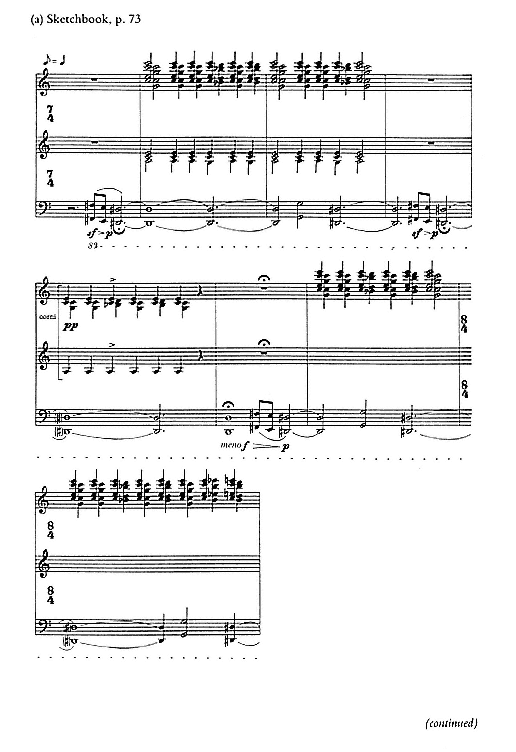
Example 9:
"Evocation of the Ancestors"
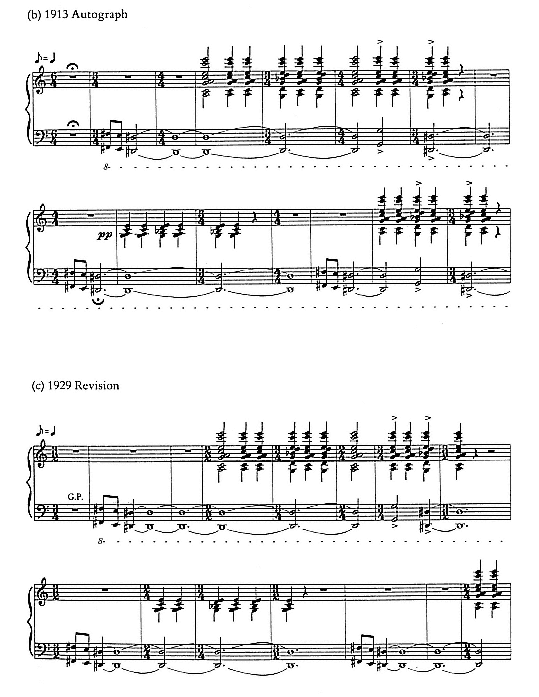
Example 9
(continued)
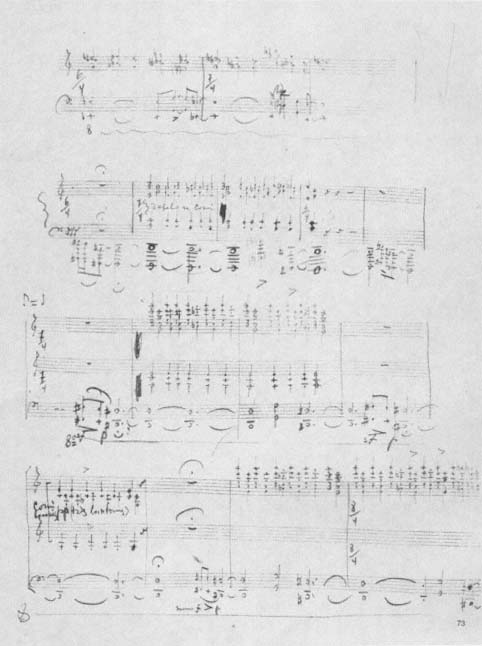
Figure 2:
Early sketches of the "Evocation of the Ancestors," page 73 of the sketchbook of The Rite .
The version transcribed in Example 9a begins at the third line with the

The Rite of Spring (Le Sacre du Printemps) Sketches, 1911–1913, © copyright 1969
Boosey & Hawkes Music Publishers Ltd. Reprinted by permission of Boosey & Hawkes, Inc.
For although the barring of a particular motive may remain constant, this constancy may not always be felt as primary. Upon successive repeats, a motive may assume a changed rhythmic-metric identity, which hinges in turn on the felt presence of a second (concealed) meter.
Much later, in Expositions and Developments (1962), Stravinsky explained that with the longer measures in his earlier versions of both the "Evocation" and the "Sacrificial Dance" he had sought "to measure according to phrasing," but that later on, in 1921, his performance experience had led him "to prefer smaller divisions"; the "smaller divisions," he averred, "proved more manageable for both conductor and orchestra and they greatly simplified the scansion of the music."[50] But as can readily be seen in Examples 9a–9c, the different proportions that distinguish the three versions of the "Evocation" could hardly have been matters of practical convenience. Even if they had, method would presumably have intervened at some point. Observe that the "smaller divisions" of the 1913 autograph in Example 9b are quite different from those of the 1929 revision in Example 9c. Indeed, while the later subdivisions doubtless proved, for conductor and orchestra alike, "more manageable" than the




All the same, Stravinsky's recollection of having measured the "Evocation"'s longer bars "according to phrasing" is revealing. The problem here, however, is that the "smaller divisions" of the 1913 and 1929 versions are really no different in this respect. They, too, are a form of phrasing, even if the conception of this phrasing is different from that of the original sketchbook. Indeed, all three versions of the "Evocation" in Examples 9a–9c introduce the same startling departure in rhythmic-metric design: as in so many of Stravinsky's block structures with irregular or shifting meters, meter and phrasing (or grouping ) coincide. On at least one hierarchical level, meter becomes a form of phrasing while phrasing becomes meter or "measure."
[50] Stravinsky and Craft, Expositions and Developments , p. 147.
The absence of phrase markings in the "Evocation" is to be remarked, as is, throughout The Rite generally, the absence of phrase markings that contradict the bar lines. A more conventional phrasing is found in certain passages of Part II's Introduction and "Mystic Circles"—and it was of course precisely the slow, chromatic lyricism of this music, its evidently non-idiomatic, Debussy-like character, that when compared to the more rhythmically active material of the initial sketches of the "Glorification," "Evocation," and "Sacrificial Dance" proved uniquely difficult for the composer.
What in turn saves this one-dimensional rhythmic-metric approach from sterility are the differing lengths of the juxtaposed blocks upon successive appearances, the lengthening or shortening of the motivic reiteration within these blocks, and the resulting play in rhythmic-metric identity which, although frequently concealed by a shifting meter which graphically preserves identity, lies at the heart of the invention.
Examples 10a–10c further condense the opening measures of the three "Evocation" versions. In Example 10b the subdivisions of the 1913 autograph are closely related to the original

In contrast to the 1913 autograph in Example 10b, the "smaller divisions" of the 1929 revision in Example 10c are a radical departure. Here, the earlier sevens, to which the subdivisions of the 1913 autograph closely adhere, are obscured beyond meaningful apprehension after the first two measures. The rhythm at m. 1 is not preserved at m. 3 as it is in the 1913 autograph, and the 4 + 3 subdivision at mm. 1-2 is not merely reproduced at mm. 3-4. Rather, the 4 + 3 subdivision at mm. 3-4 is now 2 + 3, which means that the shifting meter will actually record the shortening of the motivic reiteration. Hence, too, the termination of the shortened reiteration occurs on the downbeat at m. 5, which will now parallel the downbeat at m. 3. Yet the chief distinction of this 1929 revision is its introduction of the half-note beat as a unit of pulsation,
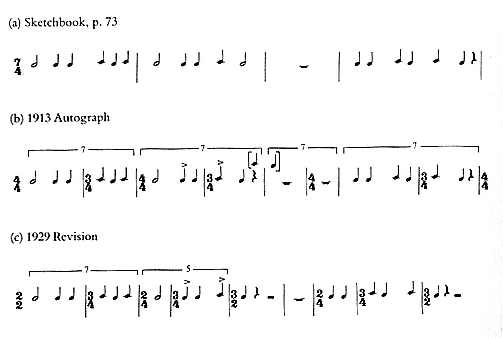
Example 10:
"Evocation of the Ancestors"
which partially replaces the prevailing quarter-note beat of the earlier versions. This is naturally consistent with the enlarged dimensions of this revision, as discussed above. Then, set against the half-note pulse, the



Stravinsky's conception of "phrasing" seems again very much to the point in the sketchbook version of the second section of the "Sacrificial Dance." As in the preceding illustrations, three versions of the opening measures of this section are cited: Example 11a is from pages 90–91 of the sketchbook,[51] Example 11b follows all editions of the full score beginning with the
[51] The entry on pages 90–91 of the sketchbook is actually a full orchestral draft of the music. This is condensed in Example 11a in order to focus more closely on the barring.
1913 autograph, while Example 11c is from the 1943 revision of the "Sacrificial Dance" alone. As in the three versions of the "Evocation," here the early sketchbook version is characterized by longer measures (or longer "phrases") which in subsequent editions are sliced up into "smaller divisions" (or smaller "phrases"). But notice that the longer groupings of the sketchbook version
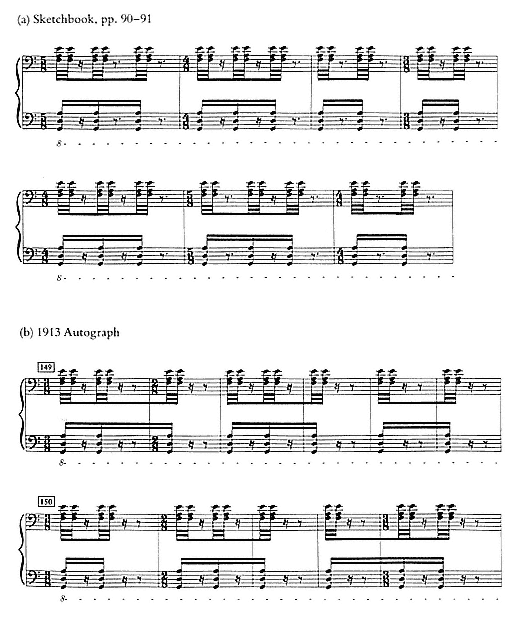
Example 11:
"Sacrificial Dance"
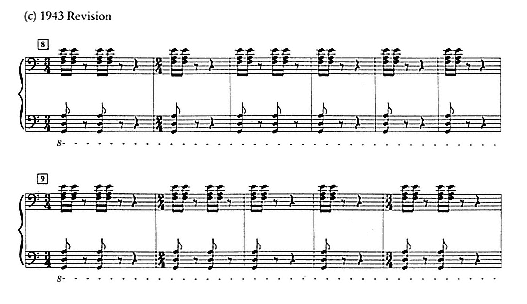
Example 11
(continued)
are preserved in subsequent editions by means of beams that cross the bar lines. The 1943 revision in Example 11c retains the subdivisions but opts for "an easier-to-read unit of beat," which, as Stravinsky later explained, was designed to facilitate performance.[52] Quite simply, eighth-notes become quarters. Yet the disadvantage of the 1943 revision is that the earlier, longer groupings are ignored. Single beams over the bar lines could have preserved some of the earlier connections, but these, too, are sacrificed, presumably in the interests of facility or simple legibility. (The longer groupings or "rhythmic cells" of Examples 11a and 11b are the ones upon which Pierre Boulez based his rather extensive analysis of this passage.)[53]
The idea behind the music at nos. 149-54 in the "Sacrificial Dance" is quite simple. In accord with a single beat or unit of pulsation (the quarter-note in Example 11c), a single chord is punctuated one, two, or three times in succession. These punctuations or successions of punctuations are always separated by a single unit of rest. To a large extent, the metrical subdivisions in Examples 11b and 11c reflect this smaller and simpler conception: the downbeats of these subdivisions coincide with the beginnings of these smaller
[52] Stravinsky and Craft, Expositions and Developments , p. 147.
[53] Pierre Boulez, Notes of an Apprenticeship , trans. Herbert Weinstock (New York: Knopf, 1968), pp. 84-88.
groupings. The exception occurs at the third and fourth measures in Examples 11b and 11c, which, to accord with the simpler conception, should have been combined as a single



The one-dimensional approach noted above applies in all three versions of Examples 11a–11c: with or without subdivisions, meter and phrase coincide, are here wholly "in phase" (to borrow a term from the recent work of Lerdahl and Jackendoff).[54] And the rhythmic play that develops occurs precisely at those points where the groupings are reproduced. In the 1943 revision of Example 11c, the groupings at mm. 3-5 are reproduced at mm. 8-10. Is this metrically exposed repeat heard as such? If not, then we are again dealing with a metrical scheme not graphically in evidence.
As a final illustration, four different versions of the opening measures of the "Sacrificial Dance" are cited in Examples 12a–12d. Once again the sketchbook begins with longer measures which in subsequent versions are subjected to "smaller divisions": the

The 1943 revision also changed the harmony of the very first chord. It began at the outset with the (E












As was indicated above, the 1943 revision of the "Sacrificial Dance" did not become a part of the now widely used 1948, 1965, and 1967 editions of the score. Had a settlement been possible between Associated Music Publishers
[54] Fred Lerdahl and Ray Jackendoff, A Generative Theory of Tonal Music (Cambridge, Mass.: MIT Press, 1983), p. 30.
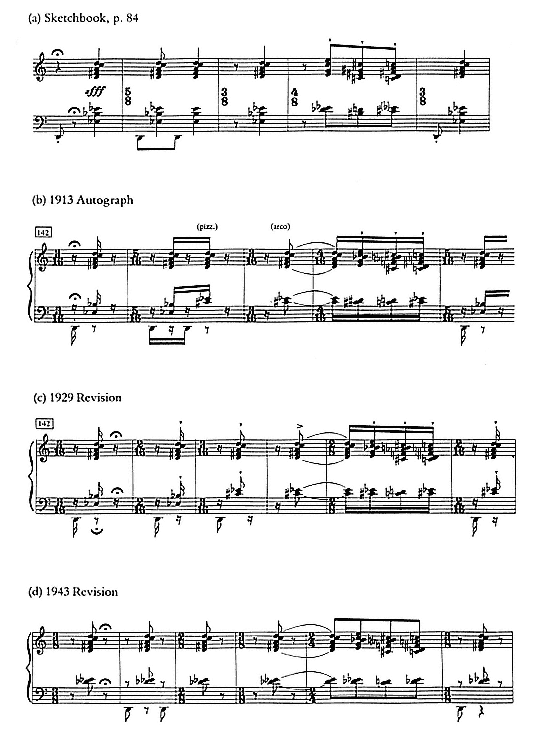
Example 12:
"Sacrificial Dance"

Example 13:
"Sacrificial Dance" Sketchbook, p. 84 1913 Autograph 1943 Revision
and Boosey and Hawkes in the late 1940s and had Stravinsky been willing and able to continue with his revisions for the remainder of The Rite, something like a "final version" might well have emerged as a convenient cap to several decades of incessant tampering. The absence of such a version is to be regretted, all the more since it has placed the 1943 revision of the "Sacrificial Dance" in an awkwardly peripheral position.
Here again Stravinsky no doubt had his reasons. As he later explained, he preferred composing anew to merely recomposing the old: "I would go on eternally revising my music . . . were I not too busy composing more of it."[55] Yet the turbulent history of The Rite 's revisions suggests a nagging dissatisfaction with certain particulars of the music itself. (Stravinsky remained dissatisfied with the final chord of the piece even after the substantial alterations of the 1943 revision.) With so many notes, and with such variety of structure for such a large orchestra, The Rite may have seemed burdened by problematic details that were beyond any conclusive formulation. In the end, Stravinsky may have been put off by the futility of a "definitive" effort.
All versions and editions of The Rite will be taken into consideration in the present inquiry. Ultimate authority rests with the newly engraved 1967 edition of the full score and with the 1943 revision of the "Sacrificial Dance." Yet the earlier versions, especially when in substantial disagreement with the later ones, offer considerable insight into Stravinsky's methods. They will remain points of reference.
[55] Stravinsky and Craft, Expositions and Developments , p. 147. See also V. Stravinsky and Craft, Stravinsky in Pictures and Documents , p. 531, where Craft prints Stravinsky's notations on the margin of a letter from Edwin Stein dated September, 1948. Stein, editor at Boosey and Hawkes, had inquired about the numerous errors in the existing scores of The Rite , to which the composer replied: "Have no time for it. I prefer to compose a new music rather than losing time on this old one."